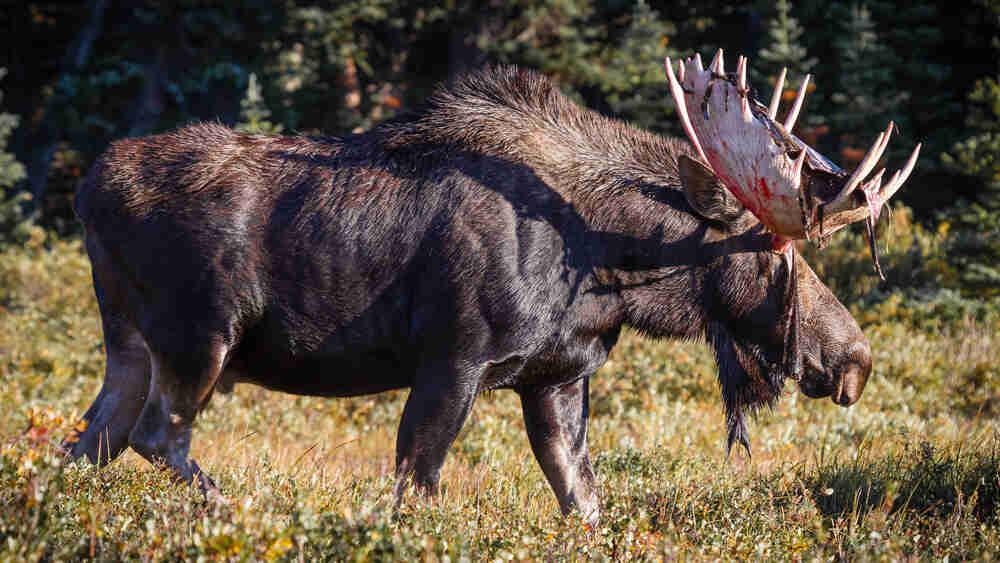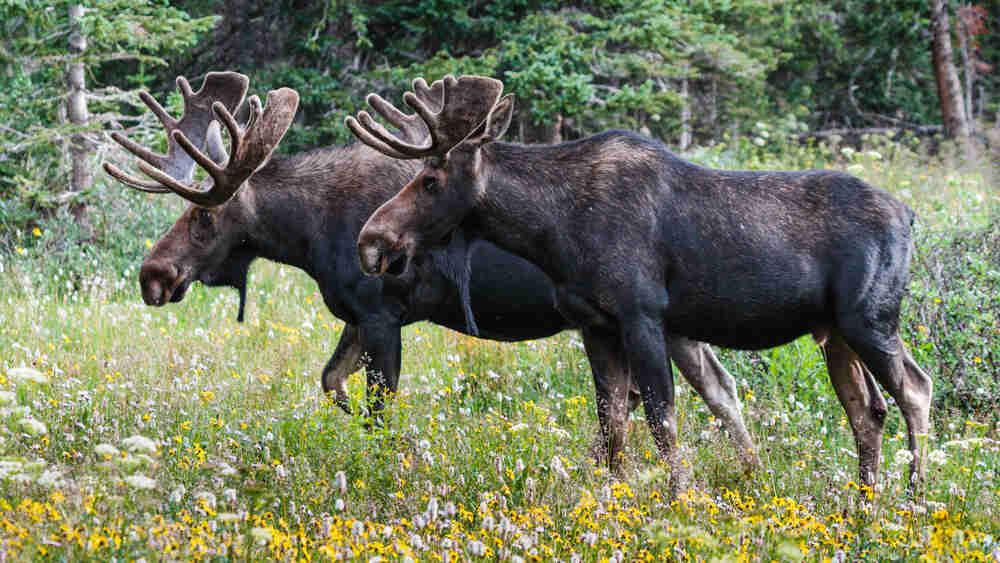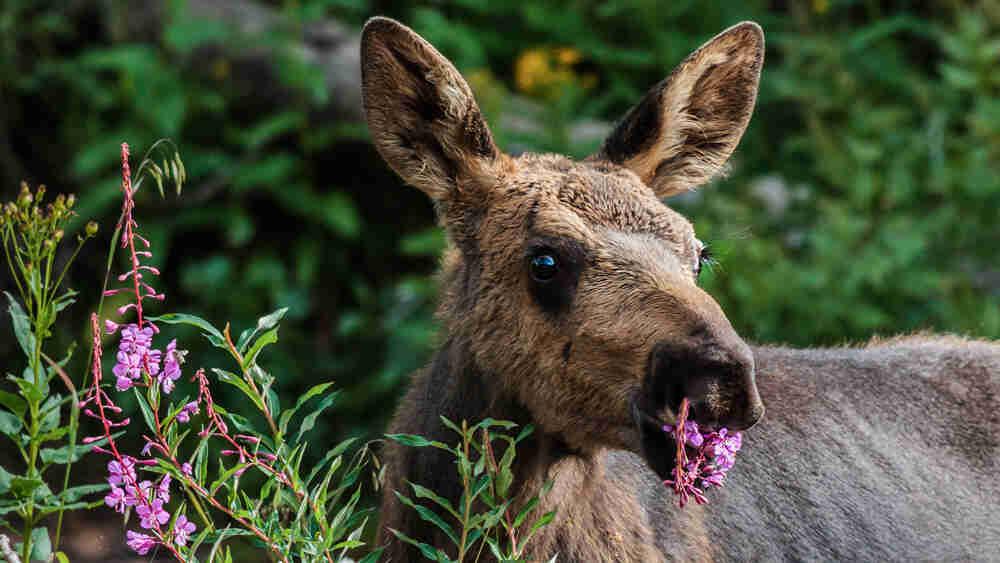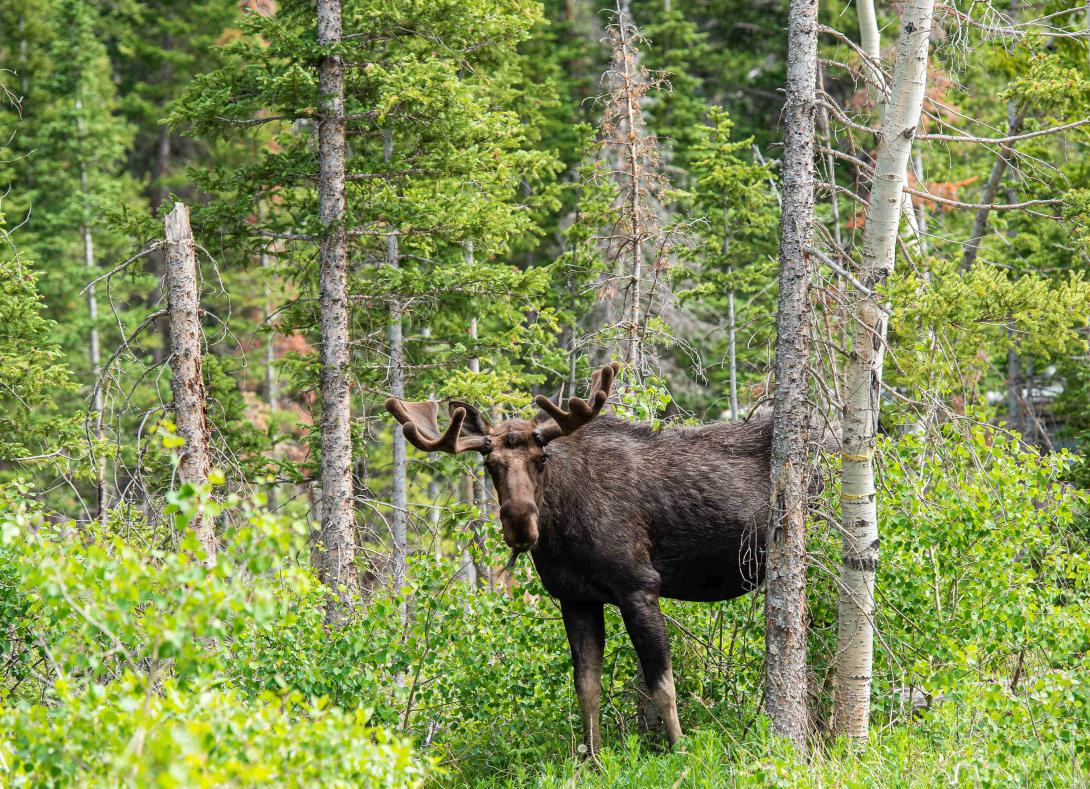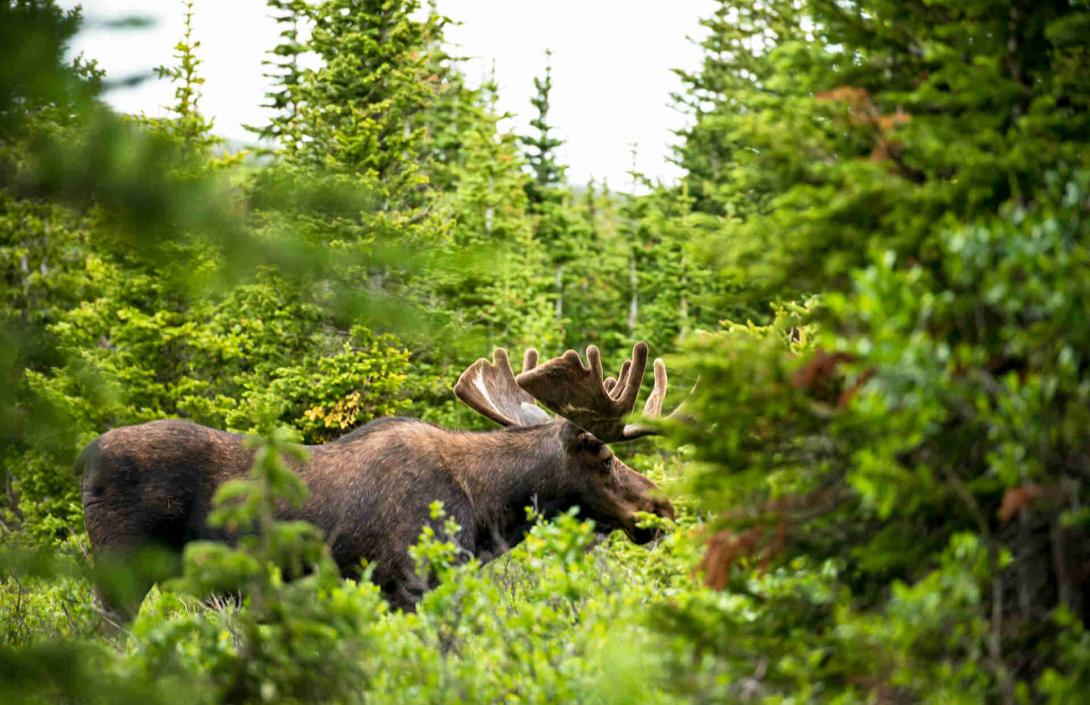Moose
Full Article
Moose (Alces alces shirasi) are the largest member of the deer family, with individuals reaching weights of between 800 and 900 pounds. The subspecies of moose found in Colorado, as well as throughout the southern Rocky Mountains, is the Shiras subspecies. This subspecies is smaller than that of northern latitudes, particularly in regards to antler size. Moose were almost nonexistent in Colorado until they were introduced in the late 1970s. Today, the large ungulates can be found in many densely forested parts of the state, drawing respect and admiration from residents, tourists, and big-game hunters alike.
History
The nativity of moose in Colorado is a subject of debate. There is no evidence to suggest that breeding populations existed in Colorado before deliberate transplantation efforts during the late 1970s and early 1980s. However, early settlers and miners observed and occasionally harvested individual animals. These animals were likely young bulls that had dispersed from established herds in Utah and Wyoming. However, since 1978, several healthy and productive moose herds have been established throughout Colorado. The spatial distribution of moose in the state has steadily grown since then, due to natural dispersal as well as deliberate translocation efforts by Colorado Parks and Wildlife.
Characteristics and Habitat
Mature individuals of the Shiras subspecies can reach weights between 800–900 pounds. Moose coat color is typically black, although individual animals with lighter colored coats can appear tawny. White-colored guard hairs are often observed at the lower ends of legs. Bull moose are often recognized by their large, palm-shaped antlers. Bull moose shed their antlers every year, typically between the middle of December and the end of January, and new antler growth occurs during spring and through the majority of the summer. Mature cows typically breed for the first time when they are two years old. The healthiest cows are capable of having twins; however, in Colorado, as well as in many other states, Shiras moose more commonly have a single calf.
Throughout their range, moose are commonly associated with willow (Salix spp.) and aspen (Populus tremuloides) trees. This characteristic holds true for moose in Colorado, but in different parts of the state moose have also become associated with more non-traditional habitat types, such as mountain shrub communities and sagebrush (Artemesia spp.), when it occurs near willow and aspen.
The seasonal migration of moose in Colorado is less defined than that of elk (Cervus elaphus) or mule deer (Odocoileus hemionus). Whereas seasonal distribution of these other species is largely regulated by snow depth at higher elevations, the moose’s large size enables individual animals to tolerate deeper snow and remain at higher elevations during winter.
Interaction with People
Moose are a large and easily observed species. Under many circumstances the flight response of moose is less than that of other wild and free-ranging animals. When coupled with the unique and large antler characteristics of bulls, moose are often recognized for their value as a watchable wildlife species. However, the docile nature of moose should not be taken for granted. Moose can quickly become aggressive when stressed by people or dogs; the vast majority of negative interactions with moose in Colorado involve a moose being agitated or harassed by a dog. Additionally, moose cows with calves are known to quickly take defensive action when people are nearby.
In addition to their visual appeal, moose are also a prized species for hunters. Due to the relatively low density of moose, the restricted range over which they exist, and the large number of hunters applying to hunt moose each year, moose-hunting licenses in Colorado are some of the hardest to acquire in the annual drawing.
10th Grade
Moose (Alces alces shirasi) are the largest member of the deer family. The moose found in Colorado is the Shiras subspecies. This subspecies is smaller than that of northern latitudes, especially when it comes to antler size. Moose were almost nonexistent in Colorado until they were introduced in the late 1970s. Today, they can be found in many densely forested parts of the state.
History
The nativity of moose in Colorado is a subject of debate. There is no evidence to suggest that breeding populations existed in Colorado before deliberate transplantation efforts during the late 1970s and early 1980s. However, early settlers and miners observed and occasionally harvested individual animals. These animals were likely young bulls that had dispersed from established herds in Utah and Wyoming. However, since 1978, several healthy and productive moose herds have been established throughout Colorado. The spatial distribution of moose in the state has steadily grown since then, due to natural dispersal as well as deliberate translocation efforts by Colorado Parks and Wildlife.
Characteristics and Habitat
Mature moose of the Shiras subspecies can reach weights between 800–900 pounds. Moose coat color is typically black, although animals with lighter colored coats can appear tawny. White-colored guard hairs are often observed at the lower ends of legs. Bull moose are often recognized by their large, palm-shaped antlers. Bull moose shed their antlers every year. The antlers fall off between the middle of December and the end of January. New antlers grow during spring and through the majority of the summer. Mature cows typically breed for the first time when they are two years old. The healthiest cows are capable of having twins; however, Shiras moose more commonly have a single calf.
Throughout their range, moose are commonly associated with willow (Salix spp.) and aspen (Populus tremuloides) trees. This characteristic holds true for moose in Colorado. However, in different parts of the state, moose have also become associated with more non-traditional habitat types, such as mountain shrub communities and sagebrush (Artemesia spp.), when it occurs near willow and aspen.
The seasonal migration of moose in Colorado is less defined than that of elk (Cervus elaphus) or mule deer (Odocoileus hemionus). Whereas seasonal distribution of these other species is largely regulated by snow depth at higher elevations, the moose’s large size enables individual animals to tolerate deeper snow and remain at higher elevations during winter.
Interaction with People
Moose are a large and easily observed species. However, the docile nature of moose should not be taken for granted. Moose can become aggressive when stressed by people or dogs. The vast majority of negative interactions with moose in Colorado involve a moose being agitated or harassed by a dog. Additionally, moose cows with calves are known to quickly take defensive action when people are nearby.
Moose are a prized species for hunters. Due to the relatively low density of moose, the restricted range over which they exist, and the large number of hunters applying to hunt moose each year, moose-hunting licenses in Colorado are some of the hardest to acquire in the annual drawing.
8th Grade
Moose are the largest member of the deer family. The moose found in Colorado is the Shiras subspecies. This subspecies is smaller than other moose, especially when it comes to antler size.
Moose were almost nonexistent in Colorado until they were introduced in the late 1970s. Today, they can be found in many densely forested parts of the state.
History
The nativity of moose in Colorado is a subject of debate. There is no evidence breeding populations existed before transplantation efforts in the late 1970s and early 1980s. Early settlers and miners observed and sometimes killed moose. These were likely young males from established herds in Utah and Wyoming. Since 1978, several healthy and productive moose herds have grown in Colorado.
Characteristics and Habitat
Mature moose of the Shiras subspecies can reach weights between 800–900 pounds. Moose coat color is typically black, although animals with lighter colored coats can appear tawny. White-colored guard hairs are often observed at the lower ends of legs. Bull moose are often recognized by their large, palm-shaped antlers. Bull moose shed their antlers every year. The antlers fall off between December and January. New antlers grow during spring and summer.
Mature cows typically breed for the first time when they are two years old. Healthy cows can have twins. However, Shiras moose more commonly have a single calf.
Throughout their range, moose are commonly associated with willow and aspen trees. However, moose have also become associated with more non-traditional habitat types. They can be found in mountain shrub communities and sagebrush when it occurs near willow and aspen.
The seasonal migration of moose in Colorado is less defined than that of elk or mule deer. Migration of these other species is largely controlled by snow depth at higher elevations. The moose’s large size enables them to tolerate deeper snow and remain at higher elevations during winter.
Interaction with People
Moose are a large and easily observed species. However, the docile nature of moose should not be taken for granted. Moose can become aggressive when stressed by people or dogs. The majority of negative interactions with moose involve a moose being harassed by a dog. Additionally, moose cows with calves are known to quickly take defensive action when people are nearby.
Moose are a prized species for hunters. Due to the low density of moose, their restricted range, and the large number of hunters applying to hunt moose each year, moose-hunting licenses in Colorado are some of the hardest to acquire in the annual drawing.
4th Grade
Moose are the largest member of the deer family. The moose in Colorado is the smaller Shiras subspecies.
Moose were once hard to find in Colorado. Their numbers increased when moose were introduced in the late 1970s. Today, moose can be found in forested parts of the state.
History
Early settlers and miners saw and sometimes killed moose. These animals were likely young males that had left herds in Utah and Wyoming.
Since 1978, healthy and productive moose herds have grown in Colorado.
Characteristics and Habitat
Mature moose can weigh between 800–900 pounds. Their coat color is typically black. Animals with lighter colored coats can appear brown.
Bull moose are known for their palm-shaped antlers. They shed their antlers every year. The antlers fall off in December and January. New antlers grow during spring and summer.
Mature cows typically breed for the first time when they are two years old. Healthy cows can have twins. Shiras moose usually only have one calf.
Moose can be found near willow and aspen trees. They can also live in other areas. Moose have been seen near mountain shrubs and sagebrush that grow near willow and aspen.
Interaction with People
Moose are a large and easy to see. They can be stressed by people or dogs. Moose cows with calves can become defensive when people are near.
Moose are a prized species for hunters. Many hunters apply to hunt moose each year. Moose-hunting licenses in Colorado are some of the hardest to get.


